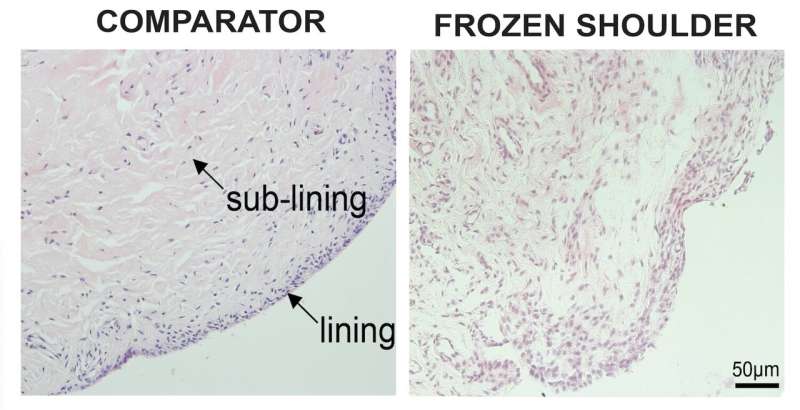This article has been reviewed according to Science X's editorial process and policies. Editors have highlighted the following attributes while ensuring the content's credibility:
fact-checked
trusted source
proofread
Frozen shoulder research may hold the key to understanding fibrosis resolution

Researchers have identified how cells work to resolve frozen shoulder, opening up potential new targets for treatment and reducing the need for surgery.
Frozen shoulder is a painful and disabling condition affecting the ligaments that form the shoulder joint capsule. Patients experience severe stiffening of their affected shoulder which can last for several years, interfering with activities of daily life.
Frozen shoulder is a unique musculoskeletal disease as it unusually resolves spontaneously over time. This distinguishes the condition from most fibrotic (scarring) diseases that are progressive and irreversible, for example knee arthrofibrosis affecting the ligaments comprising the knee capsule after joint replacement.
Senior author Professor Stephanie Dakin, Versus Arthritis Career Development Fellow, and the team at NDORMS studied tissues collected from frozen shoulder patients undergoing surgery to improve their shoulder mobility. Their work is published in the journal Nature Communications.
"We purposefully studied tissues from patients with advanced-stage frozen shoulder to understand how the condition ultimately resolves. Using cutting-edge technologies, we identified that the shoulder capsule is predominantly comprised of fibroblasts (the major cell types that form ligaments) and macrophages, a type of immune cell.
"We discovered that distinct populations of macrophages in the shoulder capsule are enriched to resolve inflammation. We performed experiments using patient-derived cells, revealing that crosstalk between these resolving macrophages and fibroblasts reduced inflammation and promoted tissue remodeling, providing us with cellular evidence of how frozen shoulder resolves.
"We next compared the resolving macrophages identified in the shoulder capsule with the same cell population found in synovial tissues from rheumatoid arthritis patients who were in disease remission. This analysis supported the initial findings that resolving macrophages brought about resolution of inflammation in synovial tissues and resolution of fibrosis in the shoulder capsule.
"Finally, we analyzed fetal shoulder tissues, identifying resolving macrophage and fibroblast populations comparable to those in frozen shoulder. This suggests that the template to resolve fibrosis is established during shoulder development," said Dakin.
Collectively, this study identifies that targeting crosstalk between resolving cell types in the shoulder capsule could accelerate resolution of frozen shoulder, addressing an unmet clinical requirement for patients and reducing the need for surgery. Importantly, this work also provides a basis for potential therapeutic resolution of persistent fibrotic diseases beyond the shoulder joint.
More information: Michael T. H. Ng et al, A single cell atlas of frozen shoulder capsule identifies features associated with inflammatory fibrosis resolution, Nature Communications (2024). DOI: 10.1038/s41467-024-45341-9


















